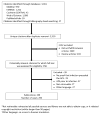Systematic review of case reports of antiphospholipid syndrome following infection
- PMID: 27060064
- PMCID: PMC7508159
- DOI: 10.1177/0961203316640912
Systematic review of case reports of antiphospholipid syndrome following infection
Abstract
Objective: The objective of this study was to conduct a systematic review of case reports documenting the development of antiphospholipid syndrome or antiphospholipid syndrome-related features after an infection.
Methods: We searched Medline, EMBASE, Web of Science, PubMed ePubs, and The Cochrane Library - CENTRAL through March 2015 without restrictions. Studies reporting cases of antiphospholipid syndrome or antiphospholipid syndrome-related features following an infection were included.
Results: Two hundred and fifty-nine publications met inclusion criteria, reporting on 293 cases. Three different groups of patients were identified; group 1 included patients who fulfilled the criteria for definitive antiphospholipid syndrome (24.6%), group 2 included patients who developed transient antiphospholipid antibodies with thromboembolic phenomena (43.7%), and group 3 included patients who developed transient antiphospholipid antibodies without thromboembolic events (31.7%). The most common preceding infection was viral (55.6%). In cases that developed thromboembolic events Human immunodeficiency and Hepatitis C viruses were the most frequently reported. Parvovirus B19 was the most common in cases that developed antibodies without thromboembolic events. Hematological manifestations and peripheral thrombosis were the most common clinical manifestations. Positive anticardiolipin antibodies were the most frequent antibodies reported, primarily coexisting IgG and IgM isotypes. Few patients in groups 1 and 2 had persistent antiphospholipid antibodies for more than 6 months. Outcome was variable with some cases reporting persistent antiphospholipid syndrome features and others achieving complete resolution of clinical events.
Conclusions: Development of antiphospholipid antibodies with all traditional manifestations of antiphospholipid syndrome were observed after variety of infections, most frequently after chronic viral infections with Human immunodeficiency and Hepatitis C. The causal relationship between infection and antiphospholipid syndrome cannot be established, but the possible contribution of various infections in the pathogenesis of antiphospholipid syndrome need further longitudinal and controlled studies to establish the incidence, and better quantify the risk and the outcomes of antiphospholipid-related events after infection.
Keywords: anticardiolipin antibodies; antiphospholipid antibodies; infection; lupus anticoagulant; systematic review.
© The Author(s) 2016.
References
-
- Miyakis S, Lockshin MD, Atsumi T, Branch DW, Brey RL, Cervera R, et al. International consensus statement on an update of the classification criteria for definite antiphospholipid syndrome (APS) Journal of thrombosis and haemostasis : JTH. 2006;4(2):295–306. - PubMed
-
- Cervera R, Piette JC, Font J, Khamashta MA, Shoenfeld Y, Camps MT, et al. Antiphospholipid syndrome: clinical and immunologic manifestations and patterns of disease expression in a cohort of 1,000 patients. Arthritis and rheumatism. 2002;46(4):1019–27. - PubMed
-
- Juby AG, Davis P. Prevalence and disease associations of certain autoantibodies in elderly patients. Clinical and investigative medicine Medecine clinique et experimentale. 1998;21(1):4–11. - PubMed
-
- Levine JS, Branch DW, Rauch J. The antiphospholipid syndrome. The New England journal of medicine. 2002;346(10):752–63. - PubMed
-
- Mchrani TPM. Epidemiology of the antiphospholipd syndrome. In: Asherson RA, editor. Handbook of systemic autoimmune diseases. Vol. 10. Amsterdam: Elsevier; 2009. pp. 13–34.
Publication types
MeSH terms
Substances
Grants and funding
LinkOut - more resources
Full Text Sources
Other Literature Sources
Medical
Miscellaneous


